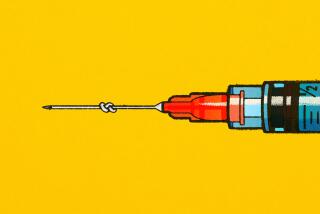DNA science points to better treatment for acne
Ancient Egyptians were vexed by it, using sulfur to dry it out. Shakespeare wrote of its “bubukles, and whelks, and knobs, and flames o’ fire.”
Today, acne plagues us still. Doctors can cure some cancers and transplant vital organs like hearts, but they still have trouble getting rid of the pimples and splotches that plague 85% of us at some time in our lives — usually, when we’re teenagers and particularly sensitive about the way we look.
But new research hints that there’s hope for zapping zits in the future, thanks to advances in genetic research.
Using state-of-the-art DNA sequencing techniques to evaluate the bacteria lurking in the pores of 101 study volunteers’ noses, scientists discovered a particular strain of Propionibacterium acnes bacteria that may be able to defend against other versions of P. acnes that pack a bigger breakout-causing punch.
As best as dermatologists can tell, zits occur when bacteria that reside in human skin, including P. acnes, feed on oils in the pores and prompt an immune response that results in red, sometimes pus-filled bumps. But the study subjects who had the newly discovered bacterial strain weren’t suffering from whiteheads or blackheads, according to a report published Thursday in the Journal of Investigative Dermatology.
Someday, the realization that “not all P. acnes are created equal” might help dermatologists devise treatments that more precisely target bad strains while allowing beneficial ones to thrive, said Dr. Noah Craft, a dermatologist at the Los Angeles Biomedical Research Institute who conducted the study with colleagues from UCLA and Washington University in St. Louis.
Doctors might prescribe probiotic creams that deliver “good” P. acnes to the face the same way a daily serving of yogurt helps restore healthy bacteria in the digestive tract.
“There are healthy strains that we need on our skin,” Craft said. “The idea that you’d use a nuclear bomb to kill everything — what we’re currently doing with antibiotics and other treatments — just doesn’t make sense.”
The research is part of a broad effort backed by the National Institutes of Health to characterize the so-called human microbiome: the trillions of microbes that live in and on our bodies and evolve along with us, sometimes causing illness and often promoting good health.
Most of the microbiome attention so far has gone to studying species in the gut, said study leader Huiying Li, an assistant professor of molecular and medical pharmacology at UCLA’s Geffen School of Medicine. But the NIH’s Human Microbiome Project, which funds her research, also looks at microbial communities in the nasal passages, the mouth, the urogenital tract and the skin.
Li said she became interested in studying acne because the skin microbiome seemed particularly understudied.
The research team recruited 101 patients in their teens and 20s from dermatology clinics in Southern California. Among them, 49 had acne and 52 had “normal skin” and were not experiencing breakouts but had come to the clinics for other problems.
Doctors used adhesive pore strips to remove skin bacteria from patients’ noses. The researchers then collected the waxy plugs — a combination of bacteria, oils, dead skin cells and other stuff — and used DNA to figure out which bacteria were present.
They found that the P. acnes species accounted for about 90% of the bacteria in pores, in both healthy patients and acne sufferers. Digging a little deeper into the DNA, they found that two particular strains appeared in about 20% of acne sufferers, while a third strain was found only in acne-free patients.
“Dogs are dogs, but a Chihuahua isn’t a Great Dane,” Craft said. “People with acne had pit bulls on their skin. Healthy people had poodles.”
The team then sequenced the complete genomes — about 2.6 million base pairs apiece — of 66 of the P. acnes specimens to explore in more depth how the good and bad strains differed.
The two notable bad strains had genes, probably picked up from other bacteria or viruses, that are thought to change the shape of a microbe to make it more virulent. The researchers hypothesized that the foreign DNA, perhaps by sticking more effectively to human host tissues, may help trigger an inflammatory response in the skin: acne.
The good strain, on the other hand, contained an element known to work like an immune system in bacteria, Li said. Perhaps it allows this P. acne to fight off intruders and prevent pimples from forming.
Li said the researchers did not know why some people had the bad P. acnes strains and others did not, and whether genetics or environment played a bigger role.
Dr. Vincent Young, who conducts microbiome research at the University of Michigan Medical School but wasn’t involved in the acne project, said advances in sequencing technology and analysis made the new study possible. In the past, he said, scientists wouldn’t have tried to sequence dozens of genomes in a single species.
“They’d say, why waste the money?” he said. “Now you can do this in a couple of days.”
Li and Craft — neither of whom suffered bad acne as teens — plan to keep up the work.
More research is needed to come up with super-targeted anti-microbial therapies, or to develop a probiotic cream for acne sufferers.
Craft continues collecting samples from patients’ pores. He hopes to study whether twins share the same microbial profiles, how acne severity is reflected in bacteria populations, and how things change in a single patient over the course of a treatment regimen.
One of the study volunteers, 19-year-old UC Santa Cruz student Brandon Pritzker, said he would have loved to have treated his acne without affecting the rest of his body. When he took Accutane, he suffered back pain and mood shifts.
Now off the drug, Pritzker said he is at peace with his pimples. “I still have breakouts, but I figure I’m 19, that’s the way it’s going to be,” he said.
But, he added, “it hindered my confidence at the time. Kids with clear skin are probably a little happier.”
For the Record: 12:13 p.m. Feb. 28: The name of a study volunteer from UC Santa Cruz was misspelled. His name is Brandon Pritzkat.







